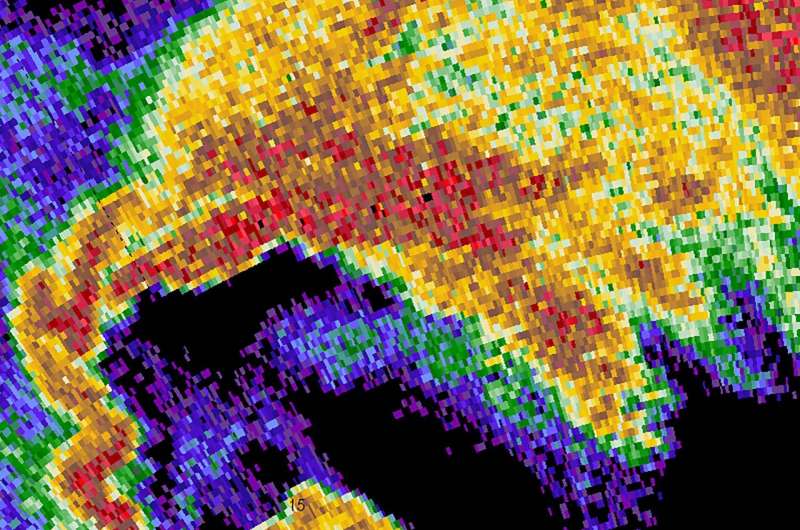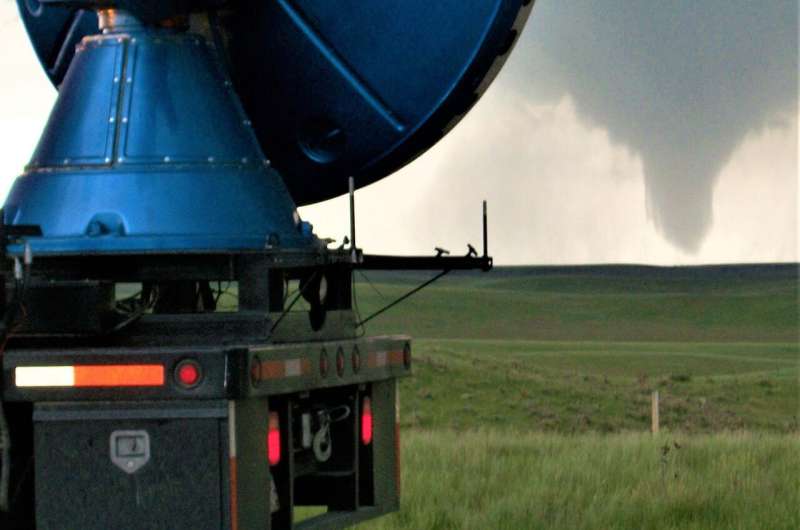A "hook echo" and tornado as mapped at fine-scale resolution by a Doppler On Wheels (DOW) radar. Credit: Center for Severe Weather Research.
A small team of researchers with the Center for Severe Weather Research, in Boulder, Colorado, has found evidence that suggests many tornados in the U.S. are bigger and stronger than their classification would suggest. In their paper published in Proceedings of the National Academy of Sciences, the group describes their study of tornadic activity in the U.S. and what they found.
The United States has more tornados than any other country in the world—it also has the most violent and destructive tornados. In 2020, over 1,200 tornados were reported, resulting in billions of dollars in damage. Tornados also kill 80 people in the U.S. each year on average, and injure nearly 2000. They also terrify millions. In the U.S., tornado strength is measured by officials with the National Weather Service. Since these personnel are generally not present when a tornado occurs, they must rely on an analysis of the damage that occurred.
Tornados are rated using the Enhanced Fujita scale—with ratings running from EF0 to EF5. But as the researchers with this new effort point out, using this scale ignores the strength of tornados that do no tear down man-made constructs. A tornado touching down on the prairie, for example, may produce winds strong enough to tear down a house, but if it never comes in contact with one, officials with the NWS would classify it as an EF0. To learn more about problems with the current scaling system, the researchers built a mobile radar tracking system they call Doppler on Wheels. They used the vehicle to track tornados over the years 1995 to 2006. In all, they were able to collect data on 82 tornados.
Comparing their data with storm strength estimates from the NWS, the researchers found multiple discrepancies. More specifically, they found multiple instances of tornados that were bigger and stronger than the classifications given to them by the NWS. They also found evidence that the percentage of EF5 tornados was greater than has been thought. Up until now, most weather scientists have believed that they make up just 1% of all tornados. Using Doppler on Wheels, the researchers found that the more likely percentage is 20%. Overall, they found that the ratings given by the NWS were 1.2 to 1.5 points too low.
A Doppler On Wheels (DOW) radar scanning a tornado in Wyoming. Image courtesy of the Center for Severe Weather Research. Credit: Center for Severe Weather Research.
More information: Joshua Wurman et al. Supercell tornadoes are much stronger and wider than damage-based ratings indicate, Proceedings of the National Academy of Sciences (2021). DOI: 10.1073/pnas.2021535118
Journal information: Proceedings of the National Academy of Sciences
© 2021 Science X Network

























